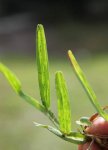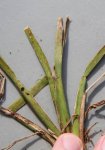Ric
Lawn Pro
- Joined
- May 7, 2010
- Threads
- 142
- Messages
- 5,765
A plant disease linked to sugarcane that had largely vanished 40 years ago has suddenly reappeared, becoming the first virus in the state to attack South Florida's manicured lawns.
Scientists don't know why the disease suddenly morphed and began spreading in Palm Beach and Pinellas counties. And so far they have no tools to stop it, other than cleaning lawn equipment or replacing sod with more resilient varieties, said Phil Harmon, a plant pathologist with the University of Florida's Institute of Food and Agricultural Sciences.
At this point we don't know what the outcome will be, so were being proactive and trying to get the word out, Harmon said.
Called Sugarcane Mosaic Virus, the disease first appeared in sugarcane and sod growing near cane fields in the 1960s, Harmon said. To control the disease, growers developed resistant sugarcane. The virus virtually disappeared, only appearing sporadically in grass near cane fields and only causing yellowing.
But in 2013 something changed, he said. Lawns with the popular Floratam St. Augustine grass, the most widely used in landscaping, started dying. The virus adapted somewhere to kill this variety of turf grass, Harmon said.
When the grass started dying at a Boynton Beach subdivision last fall, Greg Russell, a field supervisor with Hometown Pest Control, assumed a fungus was making it sick and applied a fungicide. The treatment didn't work. Over the spring and summer, the grass bounced back on its own, Russell said. This fall, it started dying again. And the dead patches spread. Russell tried four different treatments before he gave up in frustration and called Harmon's office for help.
A quick examination confirmed the cause: Mosaic virus. The virus has now spread to about 150 lawns, Russell said.
No matter what we did to it, nothing changed, he said. It's tough for people to hear that there's nothing we can do. Just wait it out. Scientists do not know what changed in the virus to cause it to spread, Harmon said. And while it infects other grasses, Floratam has been hit hardest, nearly always dying when it's infected. The grass can regrow, but it will carry the virus and likely die in September or October, when conditions are right for symptoms to resurface.
In addition to sugarcane, the disease has sickened corn, sorghum and other grasses, Harmon said. It is usually transmitted by lawn equipment: the sap from infected grass can stick to mowers and weed-eaters and wind up in healthy lawns.
With no chemical treatment available, Harmon said the best defense is a good offense: clean equipment with Lysol or a commercial ammonia or consider planting another kind of grass. Zoysia grass doesn't catch the virus, but has its own problems: the grass is an invasive that can spread and crowd out all other plants. The Palmetto and Bitterblue types are more resistant St. Augustine grasses, but also have their own issues, Harmon said. Bitterblue is susceptible to chinch bugs and Palmetto doesn't do well in shade.
To try to find a cure and better document the disease, Harmon said anyone who suspects the disease has infected their grass should notify UF's plant diagnostic center or logon to its Facebook page, RapidTurfgrassDiagnosticService, to post a picture.
Scientists hope to determine if the disease is more widespread than we think, Harmon said. Our concern is that it could potentially spread like it did in the ?0s We don't know what's going to happen next, but we'd like to get a better handle on where it is by getting people to send samples.



Scientists don't know why the disease suddenly morphed and began spreading in Palm Beach and Pinellas counties. And so far they have no tools to stop it, other than cleaning lawn equipment or replacing sod with more resilient varieties, said Phil Harmon, a plant pathologist with the University of Florida's Institute of Food and Agricultural Sciences.
At this point we don't know what the outcome will be, so were being proactive and trying to get the word out, Harmon said.
Called Sugarcane Mosaic Virus, the disease first appeared in sugarcane and sod growing near cane fields in the 1960s, Harmon said. To control the disease, growers developed resistant sugarcane. The virus virtually disappeared, only appearing sporadically in grass near cane fields and only causing yellowing.
But in 2013 something changed, he said. Lawns with the popular Floratam St. Augustine grass, the most widely used in landscaping, started dying. The virus adapted somewhere to kill this variety of turf grass, Harmon said.
When the grass started dying at a Boynton Beach subdivision last fall, Greg Russell, a field supervisor with Hometown Pest Control, assumed a fungus was making it sick and applied a fungicide. The treatment didn't work. Over the spring and summer, the grass bounced back on its own, Russell said. This fall, it started dying again. And the dead patches spread. Russell tried four different treatments before he gave up in frustration and called Harmon's office for help.
A quick examination confirmed the cause: Mosaic virus. The virus has now spread to about 150 lawns, Russell said.
No matter what we did to it, nothing changed, he said. It's tough for people to hear that there's nothing we can do. Just wait it out. Scientists do not know what changed in the virus to cause it to spread, Harmon said. And while it infects other grasses, Floratam has been hit hardest, nearly always dying when it's infected. The grass can regrow, but it will carry the virus and likely die in September or October, when conditions are right for symptoms to resurface.
In addition to sugarcane, the disease has sickened corn, sorghum and other grasses, Harmon said. It is usually transmitted by lawn equipment: the sap from infected grass can stick to mowers and weed-eaters and wind up in healthy lawns.
With no chemical treatment available, Harmon said the best defense is a good offense: clean equipment with Lysol or a commercial ammonia or consider planting another kind of grass. Zoysia grass doesn't catch the virus, but has its own problems: the grass is an invasive that can spread and crowd out all other plants. The Palmetto and Bitterblue types are more resistant St. Augustine grasses, but also have their own issues, Harmon said. Bitterblue is susceptible to chinch bugs and Palmetto doesn't do well in shade.
To try to find a cure and better document the disease, Harmon said anyone who suspects the disease has infected their grass should notify UF's plant diagnostic center or logon to its Facebook page, RapidTurfgrassDiagnosticService, to post a picture.
Scientists hope to determine if the disease is more widespread than we think, Harmon said. Our concern is that it could potentially spread like it did in the ?0s We don't know what's going to happen next, but we'd like to get a better handle on where it is by getting people to send samples.



